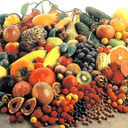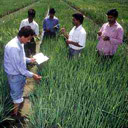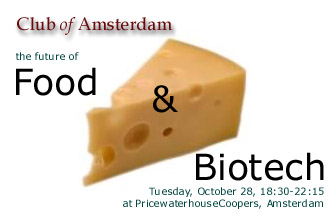
Content
Roundtable
about the future of Food & Biotech
Club of Amsterdam Search
Submit your article
Contact
Subscribe
Events 2003/2004
The Club of Amsterdam Roundtable

Thomas Thijssen
Member of the Club of Amsterdam Roundtable
“The Club of Amsterdam is needed because we need new inputs for the future: the present conditions in our world are complex. There are no easy fixes. No one organisation can fix our problems. The Club of Amsterdam is a forum for exploring our future. To develop fresh ideas on how we want our future to look like. Not only on an individual level but certainly on a community level, city level, country level and global level. It addresses important questions about our life in the future: how do we secure wealth? Economic wealth, social wealth and cultural wealth. How do we balance our lives in such a way that even for 9 billion people (in 2070) we can live on our planet in peace and with sufficient resources to share for all?
The challenge is to think and work in that direction together. The Club of Amsterdam is connecting people who care for the future, apply creativity and are committed to discover new ways to shape our future. In my view the City of Amsterdam, with its outstanding and long global tradition and brainpower, should be the centre for developing notions and actions for a better future world.”
About the future of Food & Biotech

Integrating Genomics Technologies into Food Research
by Jan Willem van der Kamp, F. Schuren & R. Montijn
The pace of development of new food products and ingredients is increasing at an unprecedented speed and the R&D to efficiently address all needs of the modern consumer regarding taste, health, safety and convenience is becoming increasingly complex.

Healthy food for Europe’s citizens
by the European Commission
The quality of the food we eat has become one the biggest concerns for Europe’s citizens. This article explains the role of the European Union (EU) in maintaining the highest standards of food safety and quality. The EU agricultural policy encourages farmers to produce a large choice of quality foodstuff, including organic production. European-wide legislation serves to keep food free of harmful substances and to keep consumers well informed though the labels on the food. The EU Food and Veterinary Office monitors whether safety rules are followed. Also the EU-activities related to new technology and to the global trade rules have an impact on our daily food.

Towards a strategic vision of life sciences and biotechnology
by EU – Life Sciences and Biotechnology
Life sciences and biotechnology have entered a stage of exponential growth, opening up a vast potential to move economies in Europe and globally towards more sustainable development and improved quality of life. They are therefore of strategic importance in Europe’s quest to become a leading knowledge-based economy. Europe cannot afford to miss the opportunity that these new sciences and technologies offer.
News about the Future
Hurricane resistant glass
A researcher at the University of Missouri-Columbia (MU) has developed a highly resistant fiberglass window panel for buildings in hurricane-prone areas.
“When a Category 3 hurricane hits with winds up to 120 miles per hour, small particles such as gravel can travel at speeds of 60 miles per hour or higher,” said Sanjeev Khanna, associate professor of mechanical and aerospace engineering at MU. “Even wood and pieces of furniture get picked up. These items can break glass window panels and cause severe damage. Our new glass will dramatically curb the amount of destruction.”
This new fiberglass reinforced window is lighter and cheaper than today’s window panels. Khanna’s panel consists of three layers, much like the present glass panels. There are two heat-treated glass sheets with a thin layer in the middle. However, unlike the normal plastic middle layer, Khanna’s layer is made of polymer that is reinforced with glass fibers.
“As with any glass panel, we’ve designed it so that if the outside glass sheet breaks, the middle, glass-fiber reinforced polymer layer disperses and dissipates the stress pulse from breaking the inside sheet,” Khanna said. “Tests, though, have found our panel, while being 30 percent lighter, is also far stronger and more durable than the present-day panels.”
New Computing Frontiers – The Wireless Vineyard
“Imagine smart farmlands where literally every vine plant will have its own sensor making sure that it gets exactly the right nutrients, exactly the right watering. Imagine the impact it could have on difficult areas of the world for agricultural purposes.” That’s Intel’s chief technology officer Pat Gelsinger on his company’s vision of what the future’s going to look like.
Intel believes that someday billions of embedded chips and sensing devices will be integrated into objects and locations that are part of our daily lives: clothing, baby cribs, cars, swimming pools, office buildings, hospitals – even vineyards and farms.
H2O Innovation signs a contract to install and commission a nanofiltration membrane filtration system to treat the groundwater
H2O Innovation Inc. signed a $360 000 contract with the Manitoba Department of Aboriginal and Northern Affairs to install and commission a nanofiltration membrane filtration system to treat the groundwater used to supply the northern community of Cormorant (Manitoba) with potable water. This is a second project for H2O Innovation in Manitoba and the result of the market development and sales efforts established by the Company.
H2O Innovation’s proposed nanofiltration membrane filtration system will provide the residents of Cormorant with potable water quality that exceeds the standards established by Health Canada in its Guidelines for Canadian Drinking Water Quality and will meet the community’s projected water demand for the next 20 years. The nanofiltration system will reduce high levels of hardness, total dissolved solids and trihalomethane precursors and will also eliminate iron, bacteria and viruses in the water.
Biotech Project
iMabs
The problem
Industrial waste flows, for instance in the agro-industry, contain a lot of proteins and other organic compounds, which are either harmful and need to be removed or highly valuable and reusable as ingredients in other products. As current technologies for bulk isolation at molecular level are very expensive, costs of purification of waste flows have increased significantly with tightened government regulation and recovery of valuable components has not been proven cost-effective.
The solution
CatchMabs provides a low cost solution for capturing valuable or harmful compounds present in minuscule amounts in bulk industrial waste flows. This solution is based on the bulk application of affinity chromatography using a proprietary, stable design of molecular affinity bodies. Using CatchMabs’ industrial affinity chromatography technology, industrial companies in a wide range of sectors can gain significant revenues by isolating and trading valuable organic compounds from their waste flows and reduce their purification costs dramatically, by low-cost isolation of harmful components. Examples are the isolation of the valuable protein lactoferrin from whey, or the removal of metal components from water.
The innovation
CatchMabs developped specially constructed industrial molecular affinity bodies (iMab®) that are optimized for bulk scale industrial application. The basic scaffold protein is designed to withstand the often harsh chemical environments of processing industries and carries a highly specific recognition site for almost any target. The simple, modular design allows for high yielding, cheap microbial production. The affinity bodies can be regenerated well over 1000 times when immobilized on a suitable matrix. Combined with the cheap production and excellent stability, the use of iMabs is 10,000 to 1,000,000 times cheaper than conventional monoclonal antibodies, the current method of choice for affinity chromatography. This substantial reduction in costs breaks down the one barrier for industrial application of antibodies. The ideas for design and potential applications of the affinity bodies have been patented.
Customers
The industrial possibilities are endless and range from compound recovery in process streams to surface reactive-dyes, from novel cosmetics to antibiotic replacements, eventually leading to ton scale sales of recombinant designer proteins. Potential customers can be found in agro-related industries, environmental industries and in the pharma- and cosmetics sector. CatchMabs’s initial focus will be on customers in the agricultural/food sector (e.g. Heinz, Campina, FCDF, Avebe, Numico, Nutreco, Genencor). This sector is especially promising, due to the high amount of valuable proteins in the processing waste flows.
Recommended Book

Genetically Modified Foods: Debating Biotechnology (Contemporary Issues Series)
by Michael Ruse (Editor), David Castle (Editor)
Presents 35 articles by experts in the fields of bioscience, law, religion, public policy, and international relations on the subject of genetically modified foods. Organized into ten sections such as the golden rice debate, religion, labeling, risk assessment, and developing countries, each section includes an introduction by the editors, followed by three or more essays.
PricewaterhouseCoopers is a supporter of the Club of Amsterdam.


Club of Amsterdam Events 2003/2004
| October 28, 2003 | the future of Food & Biotech |
| November 27, 2003 | the future of the Media & Entertainment Industry |
| January 28, 2004 | the future of the European Knowledge Society |
| February 18, 2004 | the future of Education & Learning |
| March 31, 2004 | the future of Energy – the Hydrogen Economy? |
| April 28, 2004 | the future of Healthcare & Technology |
| May 19, 2004 | the future of Architecture |
| June 23, 2004 | the future of Culture & Religion |


Leave a Reply